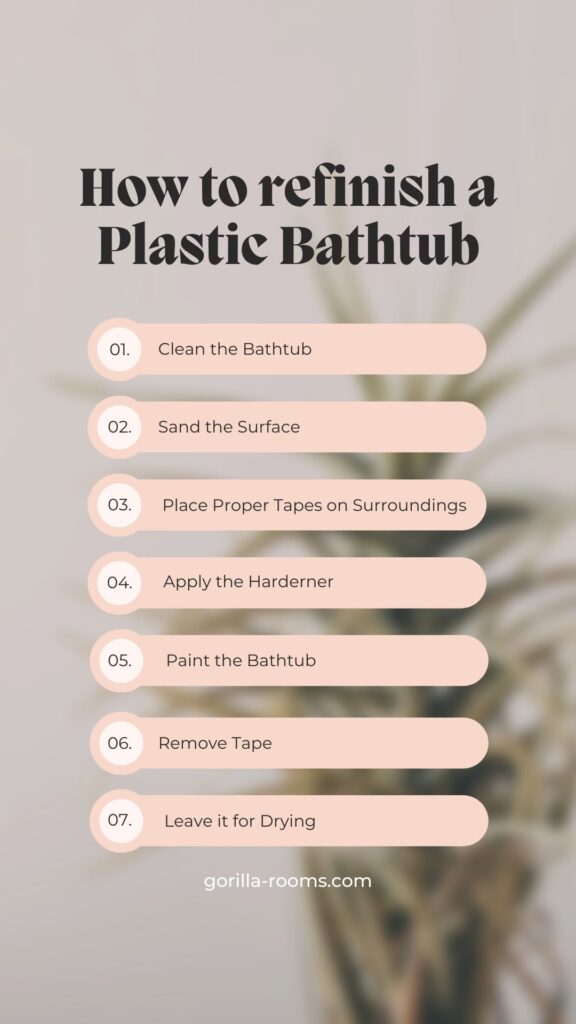Most modern bathtubs are built of plastic since it is inexpensive and holds up well to prolonged use. However, even the most long-lasting materials will eventually get worn down with age.
Plastic bathtubs may quickly lose their brilliance and seem outdated. Getting a brand-new set of fixtures for your bathroom could be tempting, but it will cost you a lot of time and money.
To revitalize or update a plastic bathtub, you may paint it.
You can paint plastic bathtub to make the atmosphere in your bathroom seem more modern and calming.
Keep on reading to no whether you can paint plastic bathtub, and what the effective ways to paint plastic bathtubs.
Can I Paint My Plastic Bathtub?
Yes, You can definitely paint your plastic bathtub and give your out-dated bathroom a completely new look.
You may also get excellent effects by painting a plastic bathtub. Plastic tubs are typically fibreglass tubs of varying sizes and styles. Some are more curved than others, while others are more linear. Even though they are naturally white or off-white, they are simple to repaint.
Since water will be present in the bathtub the majority of the time, water-resistant paint is recommended. Regrettably, a regular coat of paint won’t be able to accomplish this task.
Painting your plastic bathtub is a simple and inexpensive method to update the appearance of your bathroom without having to invest in a complete makeover.
Best Way To Paint A Plastic Bathtub – Steps

Preparation is the key to a successful outcome while working on home renovation projects. Be sure to obtain professional help if you need it, or at least read the directions carefully. Drop cloths should be utilized to protect the floor of your work area.
While painting, this will prevent any accidents from ruining your day and the floors below. Use extreme caution while climbing ladders to prevent injuries caused by slipping or falling. When painting a plastic bathtub, it’s best to use specialized paints.
Let’s go over the process in detail:
- Using your standard cleaner, scrape soapy residue, grease, and debris from the surface of your plastic bathtub.
- Using 200-grit sandpaper, scuff-sand the outer layer to improve paint adhesion. Use sandpaper until it is worn down. Then, use lukewarm water to remove the sand particles from your bathtub. Allow for complete drying.
- Fix cracks, dents, and scratches using epoxy filler, and then flatten them out with a craft knife. Leave the epoxy to cure for twenty-four hours.
- Cover the surrounding taps, tiles, and other fittings with paper tape to prevent the primer from spreading
- You may forgo priming the surface if you use paints made specifically to adhere to plastic.
- Putting primer or a binder is the next process before painting. It will be essential for a successful conclusion. Let the primer set for at least two to three hours before painting your desired color.
- Stir and shake the paint before pouring one-third of it into a plastic paint tray. Read all mixing directions to the full.
- Put the paint with a paintbrush on difficult-to-reach spots. It covers corners, drains, and the areas around fixtures.
- Using only a paint roller, apply the paint to the remainder of the bathtub. Add three coats, giving 1 to 2 hours of drying time between each.
- Discard the paper tape and let the bathtub dry. Before utilizing your newly refurbished bathtub, allow it to dry for two full days.
Few Considerations Before Painting A Bathtub

Before you get started, be sure you’ve taken all the appropriate safety measures. Put together a ventilation fan and a mask for breathing in. People with dust allergies should wear a respirator mask at all times.
1- Make Sure The Bathtub Is Absolutely Dry
You’ll want to empty your tub and let it dry fully. There should not be so much moisture drop on the outside. We want to achieve a condition where everything is dry and clean.
Don’t be shy about using the towel to dry off the whole tub. As a reminder, you can’t do any kind of handwork over a wet bathtub, so drying it out is a requirement.
2- Sand The Bathtub Before Painting It
Sanding the tub before painting will help the paint adhere better. Make sure you have some sandpaper of the proper grit in your repair kit. If you don’t have a refinishing kit, you can get by with 120-grit sandpaper.
Sanding the surface ensures a good hold for the paint. When sanding your bathtub, give it your whole attention.
3- Enamel Paints Are Appropriate For Bathtubs
Because of their quick drying time and durability, enamel paints are the best option for painting plastic containers.
In addition, they aid in warding against rust buildup. Moreover, they’re easy to clean with water, making them a practical choice. The paint you choose to cover the plastic in your mobile home bathtub makes a big difference.
Since enamel paint is the most effective, it should be used exclusively. Different gloss levels, from satin to high gloss, are used to categorize enamel paints.
After the first layer of paint has dried, you may gently apply a second by sanding it. If not, wait for the first layer to dry before putting anything back in the tub, including shampoo bottles.
Related Post: Can You Paint Carbon Fiber?
How To Prepare A Plastic Bathtub For Painting

Painting your bathtub is an excellent choice if you’re searching for a cost-effective method to update your bathroom.
But there are several things you must do to prepare your tub before you begin painting. Skilled results that endure for years are within your reach with the correct amount of preparation.
What you’ll have to do to get a plastic tub ready for paint is as follows:
- As a first step, scrub the inside of the bathtub. Scrub any grime, soap scum, or stains off using a soft sponge or brush with mild soap. Get the tub clean and dry out thoroughly.
- After thoroughly cleaning and drying the tub, sand it gently with fine-grit sandpaper to roughen the surface and improve paint adhesion. Use a moist cloth to remove dust.
- Using only a paintbrush or roller, apply a primer made for plastic surfaces. If you want to get the most out of it, use it exactly how the maker intended. Stop at this point and wait until the primer has dried.
- Utilize two coats of epoxy paint in the tub, waiting for each coat to cure completely between applications. Read the manufacturer’s guidelines if you want the greatest results and the quickest cure time.
Is It Safe To Paint A Plastic Bathtub?

When it comes to painting a bathtub in a home, you can often use the same kind of paint that you’ve used when painting a bathtub inside your own house. It is because some home tubs are constructed from an acrylic element. A plastic tub may be refinished with paint.
Many kinds of paint are suitable for this purpose. Using a suitable form of paint will aid guarantee that your tub looks fantastic for a long time.
The quickest technique to discover which sort of paint will perform effectively for you is to investigate numerous brands and kinds of paints until you locate one that looks to be a good match for your unique requirements.
How Long Does It Take To Paint A Plastic Bathtub?
It takes 1 to 2 hours to properly paint plastic bathtub, and you’re required 2 extra to remove the old bathtub’s finish. The refinishing paint will last longer if you take the time to thoroughly clean and sand the surface beforehand.
Remember that the replenishment paint will last longer if the current surface is adequately prepared by washing and sanding before application.
What Type Of Paint Can You Use On Plastic Bathtubs?
If you are prepared to put in the effort, you can use any paint on a plastic bathtub. All you need is some elbow grease. Do the research and choose a hue that satisfies your aesthetic preferences and functional requirements.
You must ensure that you select the sort of paint that is suitable for the surface you want to paint onto. Typically, anything that has been manufactured specifically for use on fiberglass surfaces.
You should use the same kind of paint on your plastic bathtub that you would use on any other surface.
Use paints that are made specifically to stick to plastic. There are a few to choose from, including Krylon Fusion for Plastic, Valspar Plastic Spray Paint, and Rust-Oleum Specialty Paint For Plastic Spray, which is all available on the market today.
In general, this is a good idea. If the walls of your tub are painted with latex-based paint, there is a chance that it may not adhere.
It is essential that the paint you use adheres well and does not experience any problems with peeling once it has dried. It does not make a difference, however, what kind of paint you use if you are going to cover a darker color with white.
If a surface is clean and dry, then any type of paint can be used to cover up stains or scratches on it. The only requirement is that the surface is clean.
Can You Spray Paint On Plastic Bathtub?
You can use a spray method to paint your Plastic Bathtub, to give it an excellent finishing look you can use an enamle spray paint. The appearance of practically anything may be altered by using a can of spray paint.
Before you can spray paint on a plastic bathtub, the bathtub’s surface must be primed. As soon as the primer is completely dry, you may start painting the tub with acrylic paint. A spray gun would be the best tool to use in order to get a more professional finish.
The best piece of advice is to make use of a spray paint that is designed to adhere to plastic; however, if you are not able to locate a color that appeals to you in that selection, you can always lightly sand the plastic in advance to create texture for improved adhesion. Once the paint has dried, you can seal it with Mod Podge.
How To Make Paint Shiny On Plastic Bathtub?
You can give your plastic bathtub a fresh and shiny look with a little effort, like you just need to ensure that you have the appropriate equipment and materials, such as a primer made of epoxy and a finish made of resin.
The secret to a flawless plastic finish is in the surface preparation. Before you begin painting, you must prepare the surface by washing it with soap and water and removing any residue from the stripping agent or chemical cleaner.
It will take much longer for the surface to dry if the humidity in the home is high when you’re doing this. Drying in a room with plenty of air circulation is also an effective method for reducing drying time.
How To Refinish A Plastic Bathtub
- Clean the surface of the plastic bathtub with a cleanser to remove soap scum, body oils, and dirt. The cleaning agent included in the bathtub refinishing kit may be used, or you can use a standard home cleaner and then follow the box’s cleaning instructions.
- To get rid of the sheen, sand your tub using 120-grit waterproof sandpaper and warm water. Remove all the grit from the sandpaper. To remove any remaining residue from the tub, just run warm water over it.
- Use epoxy filler to repair fractures, holes, and dents, and then smooth them out with a putty knife. You should wait 24 hours before touching the epoxy again.
- Cover the hardener with paper tape to prevent it from getting on nearby knobs, faucets, and other fixtures.
- After following the directions for the hardener given in the kit, you should mix and shake it before pouring a third of it into a plastic paint tray.
- Apply the hardener with a paintbrush to inaccessible spots like drains, corners, and around fixtures.
- Using a paint roller, cover the remainder of the tub with the hardener. Apply three layers of paint, waiting between applications for one to two hours.
- Afterward, after two days, remove the paper tape and the water from the tub.
Can I Use Oil Paint For Plastic Bathtub?
Oil paints may be used successfully on a plastic bathtub. Regarding durability and moisture resistance, oil-based paint wins hands down, but it’s a nuisance to work with and requires special care.
Can I Use Spray Paint Enamel For Plastic Bathtubs?
Using enamel paints on plastic is not advised since they may cause the material to melt. Unless otherwise specified on the label, latex paints cannot be used on plastic.
You might need to apply more latex paint coats than oil-based paint because of the paint’s lower viscosity.
Should I Use Spray Or Brush To Paint Plastic Bathtub?
The sort of tub you have will determine which paint is best for your walls. Yes You can use an oil-based paint and primer on a cast-iron tub and an acrylic polymer paint on an acrylic tub.
Choose between a roller, a paintbrush, and a spray painter. A spray gun will produce a much smoother and more polished finish than a paintbrush, but it will cost you. However, a spray gun may be able to achieve a level of precision that brushes and rollers cannot.
Does Painting A Plastic Bathtub Will Make It Look New?
Yes, If you want to modernize the appearance of your bathroom on a budget without spending a lot of money, painting a plastic bathtub can be a good option to consider. It is especially important to remember if you have an older tub that has been discolored or stained over its lifetime.
For instance, if your existing tub is largely free of scratches and other blemishes, it is probable that painting it will give you the pleasant, fresh appearance that you are hoping for. If this is not the case, you may want to consider replacing it with a newer model.
Does Painting A Plastic Bathtub Will Hide Stains From It?
Yes, with a little effort, bathtubs may be repainted to resemble a brand-new finish hiding stains. You only need to prepare properly, using epoxy primer and resin finish.
You may save money by reusing an oil-based undercoat or gloss that you already own. The undercoat may be used on its own, or it can be used with the gloss to make a very effective DIY stain blocker. Dry the water stain completely, paint over it with a brush or roller, and let dry.
Conclusion
The uplifting thing is that you can most certainly paint your plastic bathtub. Many have noticed that painting obsolete plastic bathtubs at home may breathe new life into them. It is an excellent method for concealing existing stains and giving your bathroom a new appearance.
However, care must be taken to accomplish each step correctly, beginning with the appropriate washing and sanding of the surface before applying primer. Also, ensure that all three coats of paint are applied uniformly and that the tub is completely dry before use.

